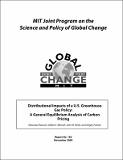Distributional Impacts of a U.S. Greenhouse Gas Policy: A General Equilibrium Analysis of Carbon Pricing
Author(s)
Paltsev, Sergey; Reilly, John M.; Metcalf, Gilbert E.; Rausch, Sebastian
DownloadMITJPSPGC_Rpt182.pdf (1.681Mb)
Metadata
Show full item recordAbstract
We develop a new model of the U.S., the U.S. Regional Energy Policy (USREP) model that is resolved for large states and regions of the U.S. and by income class and apply the model to investigate a $15 per ton CO2 equivalent price on greenhouse gas emissions. Previous estimates of distributional impacts of carbon pricing have been done outside of the model simulation and have been based on energy expenditure patterns of households in different regions and of different income levels. By estimating distributional effects within the economic model, we include the effects of changes in capital returns and wages on distribution and find that the effects are significant and work against the expenditure effects. We find the following:
First, while results based only on energy expenditure have shown carbon pricing to be regressive we find the full distributional effect to be neutral or slightly progressive. This demonstrates the importance of tracing through all economic impacts and not just focusing on spending side impacts.
Second, the ultimate impact of such a policy on households depends on how allowances, or the revenue raised from auctioning them, is used. Free distribution to firms would be highly regressive, benefiting higher income households and forcing lower income households to bear the full cost of the policy and what amounts to a transfer of wealth to higher income households. Lump sum distribution through equal-sized household rebates would make lower income households absolutely better off while shifting the costs to higher income households. Schemes that would cut taxes are generally slightly regressive but improve somewhat the overall efficiency of the program.
Third, proposed legislation would distribute allowances to local distribution companies (electricity and natural gas distributors) and public utility commissions would then determine how the value of those allowances was used. A significant risk in such a plan is that distribution to households might be perceived as lowering utility rates That reduced the efficiency of the policy we examined by 40 percent.
Finally, the states on the coasts bear little cost or can benefit because of the distribution of allowance revenue while mid-America and southern states bear the highest costs. This regional pattern reflects energy consumption and energy production difference among states. Use of allowance revenue to cut taxes generally exacerbates these regional differences because coastal states are also generally higher income states, and those with higher incomes benefit more from tax cuts.
Description
Abstract and PDF report are also available on the MIT Joint Program on the Science and Policy of Global Change website (http://globalchange.mit.edu/).
Date issued
2009-11URI
http://globalchange.mit.edu/pubs/abstract.php?publication_id=2004http://hdl.handle.net/1721.1/49862
Publisher
MIT Joint Program on the Science and Policy of Global Change
Citation
Report no. 182
Series/Report no.
;Report no. 182